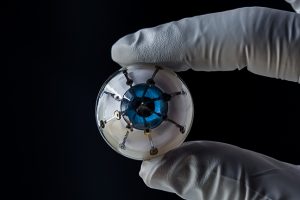We’ve all heard of the bionic man, the famous 1970’s movie and comic book story of a man who, after a tragic accident, damaged body was rebuilt and replaced with bionic, high tech parts, creating a superhuman, out-of-this-world, specimen. It turns out this sci-fi tale may soon become a reality.
According to the University of Minnesota, researchers there have successfully created the first fully 3D printed bionic eye prototype, complete with an array of light receptors that could one day help blind people see.
One of the biggest challenges the team overcame was the task of printing electronics on a curved surface like the eye. Using their custom-built 3D printer, the researchers printed a base ink of silver particles that successfully stayed in place and dried uniformly (versus running down the hemispherical glass dome). The researchers then used semiconducting polymer materials to print photodiodes, successfully converting 25 percent of light into electricity.
Nevertheless, there are still other hurdles to overcome. The team is working on creating a prototype with more light receptors, while also creating the bionic eye out of a more comfortable, wearable material. In addition, they too are still figuring out a way to convert the electric signals from the eye into something the brain can interpret.
Still, Michael McAlpine, a co-author of the study and University of Minnesota Benjamin Mayhugh Associate Professor of Mechanical Engineering, remains intent on making the bionic eye a reality, as it’s a project particularly close to his heart.
“My mother is blind in one eye,” says McAlpine, adding, “whenever I talk about my work, she says, ‘When are you going to print me a bionic eye?'”
McAlpine isn’t alone in his quest for a future that offers 3D printable technology. Ajit Khosla, a long-time ECS member, former ECS associate editor, and professor at Yamagata University in Yonezawa, Japan, will be discussing his work on 3D printable technology at AiMES 2018, including 3D Printing of Gels for Soft-matter 3D Innovation and 3D Printable Soft Conductive Nanocomposites to name a few.
AiMES 2018, taking place September 30–October 4, 2018, draws in scientists and engineers from all over the world. The ECS meeting acts as a meeting point for researchers to come together, share results, discuss ideas, concerns, and possibly collaborate.
Meet the innovators and leaders of the electrochemical and solid state field this fall. Don’t miss it.


